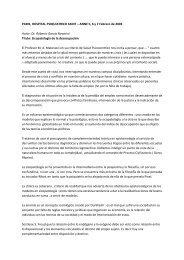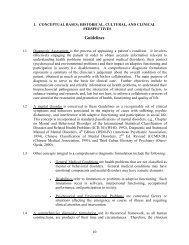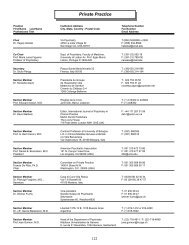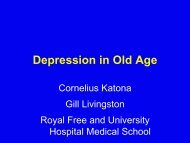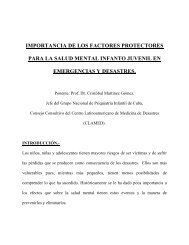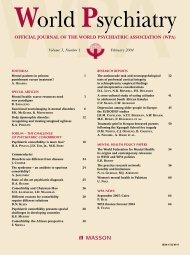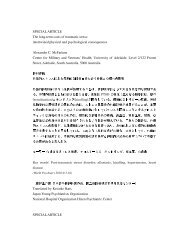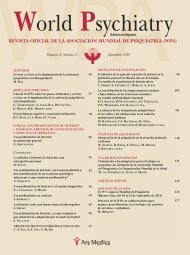ABSTRACTS - World Psychiatric Association
ABSTRACTS - World Psychiatric Association
ABSTRACTS - World Psychiatric Association
You also want an ePaper? Increase the reach of your titles
YUMPU automatically turns print PDFs into web optimized ePapers that Google loves.
carry on studying these psychoses with modern strategies and technologies.<br />
Cycloid psychoses are hypothesised as being a spectrum of<br />
neurodevelopmental disorders placed between the (bipolar) affective<br />
and the schizophrenic spectrum of psychoses.<br />
RS9.<br />
RECENT ADVANCES IN PSYCHIATRIC GENETICS<br />
RS9.1.<br />
GENETIC PREDICTORS OF ILLNESS<br />
AND TREATMENT RESPONSE<br />
A. Serretti<br />
Institute of Psychiatry, University of Bologna, Italy<br />
The recent rapid developments in psychiatric genetic research produced<br />
more confusion than clarity in many researchers even in the<br />
same field. The supposed effect of gene variants in psychiatric disorders<br />
changed during the last couple of decades. Initial findings suggested<br />
that single gene variants could be a sufficient cause of bipolar<br />
disorder or schizophrenia. The following disillusionment leaded to<br />
the hypothesis of genes as at least a cause of a subtype of each disease.<br />
Also this hypothesis was not confirmed, and during the last few years<br />
the huge technical advances flooded journals with a large number of<br />
scattered associations in many different directions. For schizophrenia,<br />
a few susceptibility genes (including dysbindin, neuroregulin-1,<br />
DAOA, DISC-1) have been consistently replicated across different<br />
samples. A similar situation exists for bipolar disorder (BDNF,<br />
DAOA, FAT, HTTLPR among the others). Depression, anxiety, and<br />
the rest of adult and child disorders, as well as personality disorders,<br />
are much less informative. Focusing on pharmacogenetics, again a<br />
large number of studies have been performed, both in schizophrenia<br />
and mood disorders. Globally, results are not so strong and universally<br />
replicated to be applied in clinical practice; however, they are so<br />
frequently reported that cannot be due to chance. In conclusion, gene<br />
variants influence human behavior, liability to disorders and treatment<br />
response. Many of them are supposed to do so in a subtle, interconnected<br />
and environment modulated way. The final stage of<br />
research will be an individualized profile of susceptibilities to be used<br />
in clinical practice.<br />
RS9.2.<br />
GENETICS OF MOOD DISORDERS<br />
N. Craddock<br />
University of Cardiff, UK<br />
The enormous public health importance of mood disorders, when<br />
considered alongside their substantial heritability, has stimulated<br />
much work, predominantly in bipolar disorder but increasingly also<br />
in unipolar depression, aimed at identifying susceptibility genes using<br />
both positional and functional molecular genetic approaches. The<br />
advent of powerful molecular genetic tools, such as genome-wide<br />
association studies of single nucleotide polymorphisms and measurement<br />
of copy number variation, has made a major impact on understanding<br />
of common non-psychiatric diseases and is starting to produce<br />
replicable findings in psychiatric phenotypes, including mood<br />
disorders. Very large samples (thousands or tens of thousands of samples)<br />
are needed and, hence, collaborations are crucial. In bipolar disorder,<br />
genes implicated at genome-wide levels of statistical significance<br />
include CACNA1C and ANK3. The product of both genes is<br />
involved in ion channel function, suggesting a key mechanism of<br />
importance in the pathogenesis of bipolar disorder.<br />
RS9.3.<br />
GENETICS OF SCHIZOPHRENIA<br />
M. Gennarelli<br />
Department of Biomedical Sciences and Biotechnology,<br />
University of Brescia, and Genetic Unit, IRCCS Fatebenefratelli,<br />
Brescia, Italy<br />
Schizophrenia is a neurodevelopment disorder with a strong genetic<br />
component and the heritability was estimated approximately at 80%.<br />
The current working hypothesis for genetic influences in schizophrenia<br />
is the “common disease-common allele” model, in which the illness<br />
is caused by a combination of common alleles, each contributing<br />
a modest effect. On this basis, several candidate genes have been<br />
identified, using linkage and association analysis approach in families<br />
and case control studies in small samples of different ethnic groups.<br />
However, replication in large samples and preliminary results of<br />
genome-wide association studies fail to identify any specific risk variant.<br />
These results are probably due to genetic heterogeneity. This is<br />
confirmed, at least in part, by the recent identification of high prevalence<br />
structural genome variants in sporadic cases of schizophrenia,<br />
suggesting that rare “de novo” germline mutations contribute to disorder<br />
susceptibility.<br />
RS9.4.<br />
GENETICS OF ANXIETY DISORDERS<br />
K. Domschke<br />
Department of Psychiatry, University of Muenster, Germany<br />
Twin studies propose a strong genetic contribution to the pathogenesis<br />
of panic disorder, with a heritability of about 48%. The present<br />
paper provides an overview of results from linkage and cytogenetic<br />
studies in panic disorder, and of association studies yielding support<br />
for several candidate genes contributing to the genetic risk for panic<br />
disorder, such as the adenosine A2A receptor, the catechol-O-methyltransferase<br />
(COMT), the monoamine oxidase A (MAO-A) and the<br />
serotonin receptor 1A (5-HT 1A<br />
) genes. Additionally, evidence for a<br />
gene-environment interaction between A2A variants and caffeine<br />
consumption is presented. Finally, functional magnetic resonance<br />
activation in brain regions critical for emotional and learning processes<br />
has been proposed as a promising intermediate phenotype for<br />
genetic studies in psychiatric disorders. Thus, applying an imaging<br />
genetics approach, recent findings with respect to the genetic influence<br />
of COMT and 5-HT 1A<br />
variants on neuronal activation correlates<br />
of emotional processing in panic disorder are reported.<br />
RS10.<br />
ARE WE WORKING WITH THE RIGHT CONCEPTS<br />
IN ALZHEIMER’S DISEASE<br />
RS10.1.<br />
IS ALZHEIMER’S DISEASE A REAL DISEASE<br />
ENTITY<br />
I. Skoog<br />
University of Gothenburg, Sweden<br />
Since being described in 1907, Alzheimer’s disease has been characterised<br />
by the presence of plaques and tangles and associated with a<br />
profound memory and language disorder that leads to a progressive<br />
dementia, loss of activities of daily living and death. It was initially<br />
used to describe a dementia in younger patients, but for many years<br />
now includes the more common late onset form which is said to<br />
39




